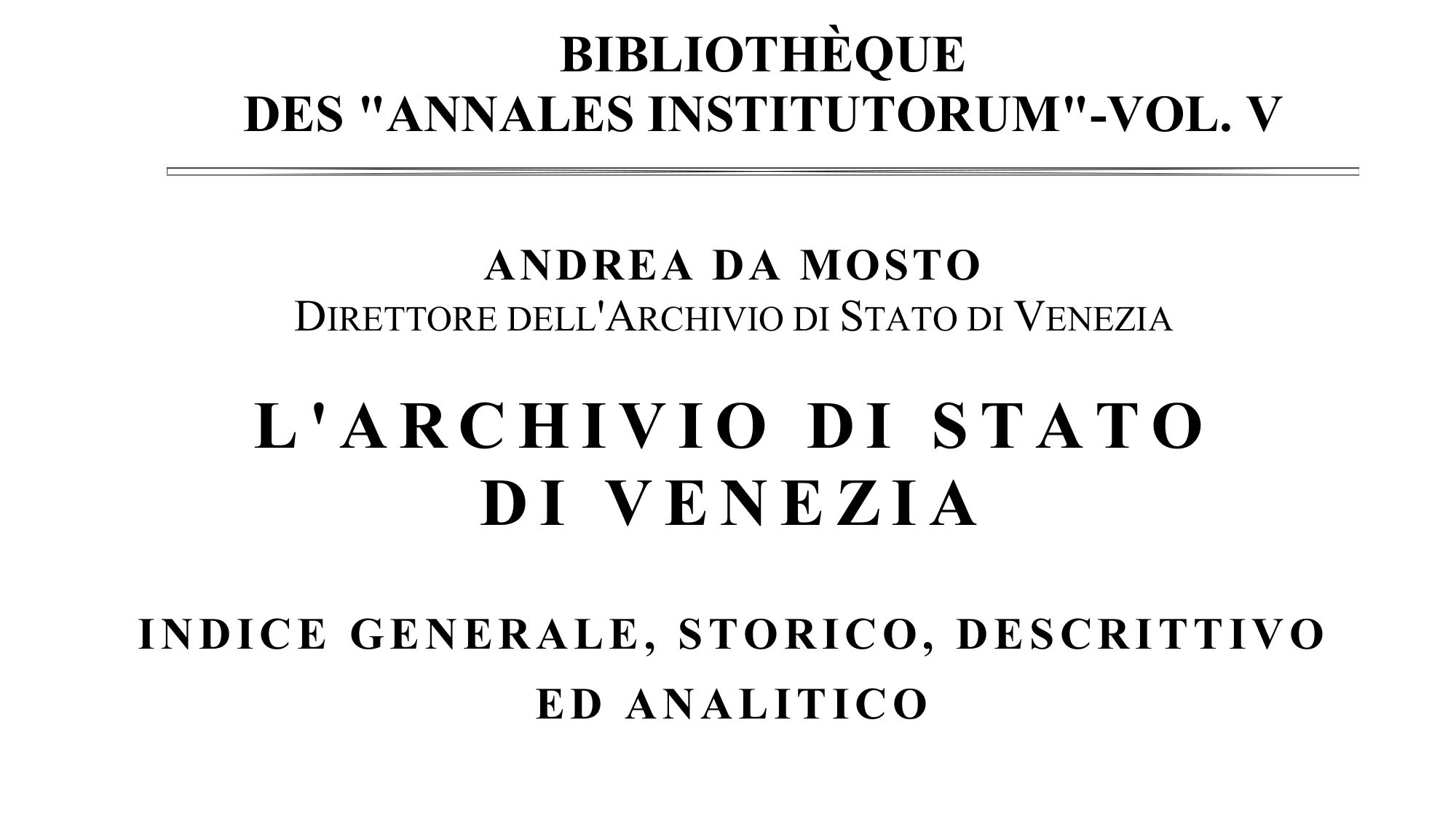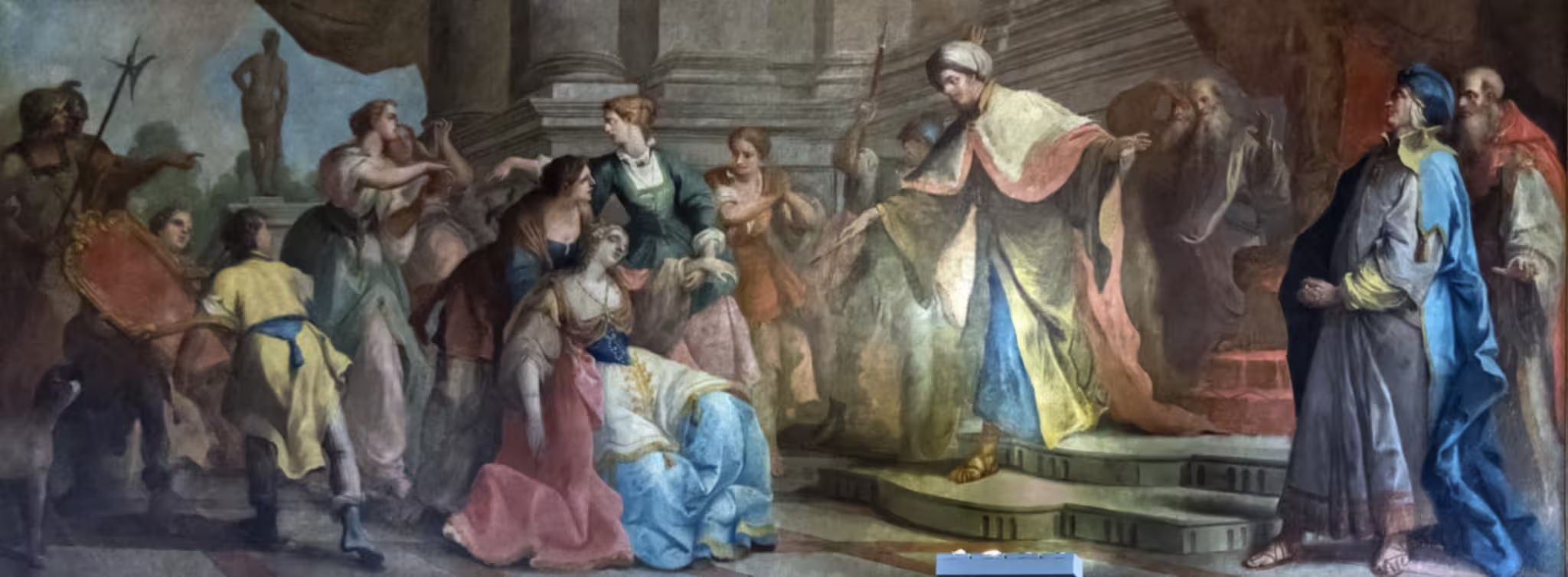Procuratore di S. Marco
The L’Archivio di Stato di Venezia: indice generale, storico, descrittivo ed analitico by Andrea Da Mosto was published in 1937. Besides being a general index of the holdings of Venetian documents in the state archive, it contains short historical descriptions of most Venetian offices and magistracies.
Andrea Da Mosto (1868-1960) was director of the Archivio di Stato di Venezia (1936-1937).
The dignity of Procuratore di S. Marco was for life. It was the most eminent in the Venetian Republic, after the ducal one. It was granted to patricians of notable families in terms of wealth and position, who had distinguished themselves with the services provided in embassies, in the command of armies, in the long exercise of the main offices of the State.
It seems that a first Procurator was appointed by the Doge in the 9th century, with the task of overseeing the construction and custody of the Church of San Marco. In 1231, another was added and the appointment was referred to the Maggior Consiglio. In 1259, a third was added, in 1261, a fourth, in 1319, two more and in 1442, they were finally brought to nine.
In 1269, the protection of orphans and lunatics, the supervision of the execution of wills and the protection and recovery of hereditary assets administered by them was delegated to the Prosecutors.
At the beginning of the 14th century, the Procurators were divided into three Procuratie. The first, called de supra, was responsible for the administration of the Basilica of St. Mark; the second, called de citra, looked after the guardianships, commissioners and wills of the sestieri of S. Marco, Castello and Cannaregio; the third, called de ultra, to the guardianships, commissioners and wills of the sestieri of Dorsoduro, San Polo and S. Croce.
To ensure that they could better carry out their tasks, it was established in 1305 that they could not take part in the Councils without a decree from the Maggior Consiglio. In 1388 it was established that only one Procurator from each Procuratia could be called to hold public offices. In 1442 it was established that they should reside in publicly owned houses in St. Mark’s Square. In 1444 they were exempted from the obligation to participate in the sessions of the Maggior Consiglio, as long as it was not a matter of discussing decrees concerning the Procuratie. In 1453 they were declared perpetual senators with the right to vote. In 1523 it was established that in the meetings of the Maggior Consiglio three Procurators per shift would occupy the loggia with armed arsenalotti1 to guarantee the safety of the Sovereign Body. In 1569 it was admitted that the Procurators could assume the office of Savio Grande of the Council at the rate of two for each Procuratia. Then they were allowed to take on other positions as well. They were sent abroad only as ambassadors extraordinarily to crowned heads.
From 1516 onwards, on several occasions, to meet the needs of the State, this dignity was granted to patricians without special merits and with the sole oblation of large sums of money, which varied according to the times from 12,000 to 100,000 ducats. These Prosecutors, who had the same rights as the others, were supernumerary and had no succession. In certain eras they reached, with those by merit, the number of forty.
Translator’s notes
- Workers from the Arsenale — the Venetian navy docks. ↩︎
Original Italian text
La dignità di Procuratore di S. Marco era a vita. Essa era la più eminente nella Veneta Repubblica, dopo quella ducale. Veniva concessa, ai patrizi di famiglie cospicue per censo e posizione, che si erano distinti con i servizi prestati nelle ambasciate, nel comando delle armate, nel lungo esercizio delle principali cariche dello Stato.
Pare che un primo Procuratore sia stato nominato dal Doge nel IX secolo, con l’incarico di attendere alla fabbrica e alla custodia della Chiesa di San Marco. Nel 1231, se ne aggiunse un altro e venne deferita la nomina al Maggior Consiglio. Nel 1259, se ne aggiunse un terzo, nel 1261, un quarto, nel 1319, altri due e nel 1442, infine vennero portati a nove.
Nel 1269, fu delegata ai Procuratori la tutela dei pupilli e dei mentecatti, la soprintendenza all’esecuzione dei testamenti e alla tutela e recupero dei beni ereditari da essi amministrati.
Al principio del sec. XIV, i Procuratori vennero divisi in tre Procuratie. La prima, detta de supra, attendeva all’amministrazione della Basilica di S. Marco; la seconda, detta de citra, attendeva alle tutele, commissarie e testamenti dei sestieri di S. Marco, Castello e Cannaregio; la terza, detta de ultra, alle tutele, commissarie e testamenti dei sestieri di Dorsoduro, San Polo e S. Croce.
Perché meglio potessero attendere ai loro compiti venne stabilito nel 1305 che non potessero prendere parte ai Consigli senza un decreto del Maggior Consiglio. Nel 1388 venne stabilito che solo un Procuratore per Procuratia potesse essere chiamato a sostenere pubblici uffici. Nel 1442 si stabilì che dovessero risiedere in pubbliche case nella Piazza di S. Marco. Nel 1444 vennero esonerati dall’obbligo di intervenire alle sedute del Maggior Consiglio, purché non si fosse trattato di discutere decreti concernenti le Procuratie. Nel 1453 vennero dichiarati senatori perpetui con diritto al voto. Nel 1523 venne stabilito che nelle riunioni del Maggior Consiglio tre Procuratori per turno occupassero con arsenalotti armati la loggetta per garantire la sicurezza del Corpo Sovrano. Nel 1569 venne ammesso che i Procuratori potessero assumere la carica di Savio Grande del Consiglio in ragione di due per Procuratia. Poi venne loro concesso di assumere anche altre cariche. Venivano mandati all’estero solo come ambasciatori straordinari a teste coronate.
Dal 1516 in poi, in più occasioni, per sopperire ai bisogni dello Stato venne concessa questa dignità a patrizi senza meriti speciali e con la sola oblazione di ingenti somme di denaro, che variarono secondo i tempi da 12.000 a 100.000 ducati. Questi Procuratori, che avevano gli stessi diritti degli altri, erano in soprannumero e non avevano successione. In certe epoche arrivarono, con quelli per merito, al numero di quaranta.
pp. 25-26.
Related articles
- Procurator di san Marco — Lessico Veneto
- Procuratori di S. Marco — Dizionario
- State institutions of the Republic of Venice




Leave a Reply